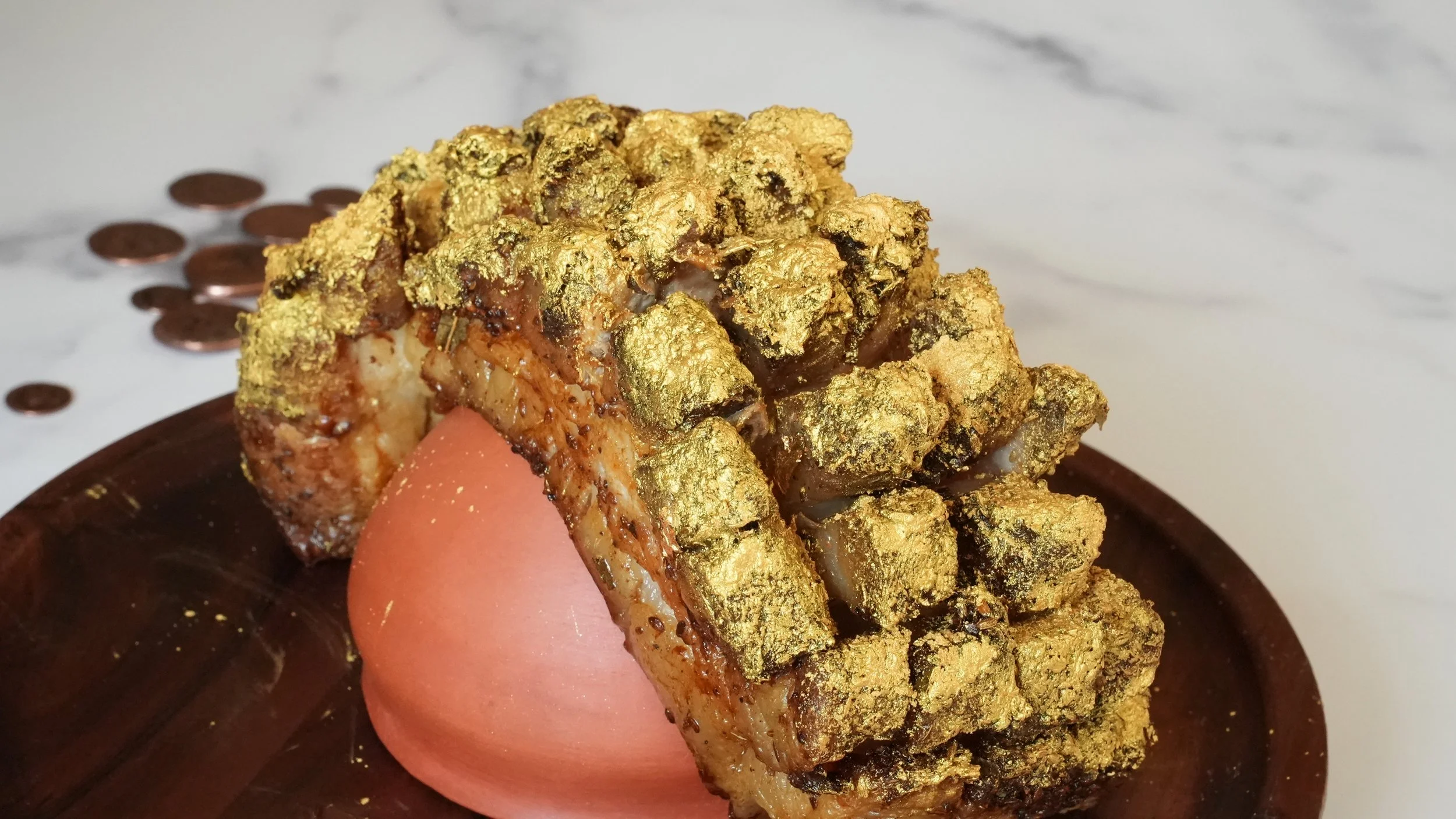Caligula’s Golden Pork Belly
Skin-on marinated and roasted pork belly decorated with edible gold paint
City/Region: Rome
Time Period: 1st Century
Caligula, the third Roman Emperor, is remembered as one of the most notorious and cruel of the lot. While he tortured and killed whomever he pleased, he also threw lavish banquets. Suetonius writes that Caligula’s reckless extravagance included “loaves and meats of gold”, and while it’s possible that he meant loaves and meats made of actual gold, I’m going with an edible interpretation.
The Roman flavors of garum, asafoetida, and other seasonings come through strongly, but aren't overpowering. The meat is wonderfully crispy while being meltingly tender, and the sauce is a nice sweet counterpoint. The gilding is, of course, optional, but it does look rather impressive.
As always, feel free to change up the amounts of anything in the marinade and sauce to suit your tastes as Apicius doesn’t give us any amounts to go on; your version will be just as authentic as this one.
“Offelas Ostienses
You slice the meat beneath the skin, so that the skin remains intact. Grind pepper, lovage, dill, cumin, silphium, and one bay laurel berry; moisten with liquamen (garum), pound. Pour over the meat pieces in a roasting pan. When they have marinated for two or three days, take them out, tie them crosswise and put them into an oven. When cooked, separate each piece, and grind pepper and lovage; moisten with liquamen, and add a little passum so that it is sweet. When it comes to a boil, thicken the sauce with starch, pour over the meat pieces and serve.”
Ingredients:
Pork Belly
- 3-5 lbs (1.33-2.25 kg) slab of pork belly with skin
- 1 teaspoon whole lovage seeds*, or fresh lovage leaves or celery leaves
- 2 teaspoons whole dill seeds
- 1 teaspoon whole cumin
- 1/8 teaspoon asafoetida*
- 1 teaspoon ground black pepper or long pepper*
- 1 bay leaf, broken into pieces
- 1 tablespoon garum* or Asian fish sauce
Sauce
- 1 tablespoon wheat starch
- 1/2 cup (120 ml) or a bit more very sweet wine, like a sauternes or an ice wine
- 1 teaspoon whole lovage seeds, or fresh lovage leaves or celery leaves
- 1/2 teaspoon ground black pepper or long pepper*
- 1 tablespoon garum* or Asian fish sauce
For Decorating
- Gold or edible gold paint, optional
*See notes below.
Instructions:
- For the pork belly: With the pork belly meat side up, cut slices lengthwise in the meat about 1 inch (2.5 cm) apart, maybe a little less, cutting very deeply, but don’t slice through the skin. Repeat the process going the other way so that you have squares of meat that are still attached to the skin, kind of like if you were cutting up a mango. Make sure the meat pieces are all separated from each other while still being attached to the skin. Set the meat in a baking dish, skin side down.
- In a dry pan over medium high heat, toast the lovage seeds, dill seeds, cumin, and asafoetida for a couple of minutes, stirring often, until they’re nice and fragrant. If you’re using lovage leaves or celery leaves, add them in step 4.
- Grind the toasted seeds to a powder in a mortar and pestle or spice grinder.
- In a small bowl, combine the ground seeds, black or long pepper, broken up bay leaf, and garum. If you’re using fresh lovage leaves or celery leaves, chop them up and add them now. Mix all of this together into a paste.
- Spread the paste over the pork belly, making sure to get it into all of the nooks and crannies. Flip the meat skin side up, cover the dish, and put it in the fridge to marinate for 2 to 3 days.
- After the meat has marinated, preheat the oven to 450°F (230°C).
- To prepare the pork belly for cooking, the goal is to make it so that each piece of meat is separated. The easiest way to do this is to run a knife under a small piece of the skin on each corner to separate it from the fat and meat, then carefully poke a hole through the lifted skin. Run a single long piece of kitchen twine through each hole, then tighten the string to pull the corners together. The meat should look even more like a mango that has been sliced. Tie the string securely.
- Place the meat back in the baking dish so that the meat is facing up. My piece of pork belly was kind of an O shape in the pan with the tied ends at the bottom. Roast for 30 minutes at 450°F (230°C), then reduce the heat to 350°F (175°C) for 1 to 1 1/2 hours, or until a thermometer stuck into the fat reaches 200°F (95°C). Pro tip: the garum and asafoetida are rather pungent, so turn on a fan or open a window, or the whole house will smell. It’s not a bad smell, it’s just very, very strong.
- When the meat is cooked, remove it from the oven and let it rest while you make the sauce.
- For the sauce: Mix the wheat starch and a couple tablespoons of the wine into a slurry.
- Grind the lovage seeds, then mix them with the pepper, garum, and remaining wine in a saucepan. Set it over medium heat and bring it to a simmer.
- When the sauce simmers, whisk in the starch mixture and turn the heat down to low. Cook until the sauce thickens, which should only take a minute or so.
- To decorate and serve: The ancient recipe says to remove the meat from the skin, but I think the presentation is more impressive if you leave them on, so do as you like. Either way, gild the pieces with some gold leaf or edible gold paint. I tried gold leaf first, but had trouble getting it to stick, so I switched to edible gold paint.
- Serve it forth with the sauce on the side for dipping. If you left the meat on the skin, you should be able to easily pick the pieces off with your fingers.
Notes
Lovage is a mildly sweet herb that can be hard to find. You can use celery leaf as a subsitute. Do not eat lovage if you are pregnant!
Asafoetida, or hing, was Rome’s pungent replacement for their beloved silphium and imparts a wonderful garlicky umami flavor when cooked. Be sure to store it in a sealed container (or two) or your whole pantry will smell sulphurous. You can find it at Indian markets or at the link below.
Long pepper was very popular in ancient Rome. It's hotter than black pepper and has a more aromatic, almost flowery quality to it that's wonderful.
Garum was a fermented fish sauce that was used in a lot of ancient Roman cooking. You can buy a modern equivalent or use an Asian fish sauce.
Link for lovage seeds: https://www.amazon.com/Seed-Needs-Planting-Levisticum-officinale/dp/B0B2ZMVVNZ/ref=sr_1_2
Link for asafoetida: https://amzn.to/4l52uuE
Link for long pepper: https://amzn.to/3ZfRLDR
Link for garum: https://amzn.to/3ulTKKW
Some links on this site are affiliate links. If you buy something through them, it does not cost you anything more, but we will get a small commission which helps keep the site up and running. Thanks!


